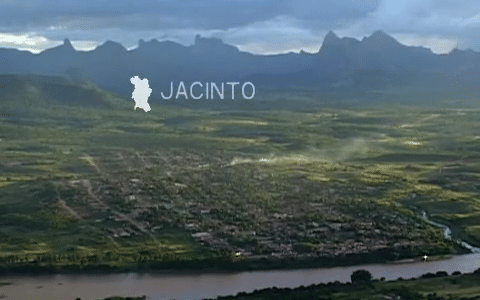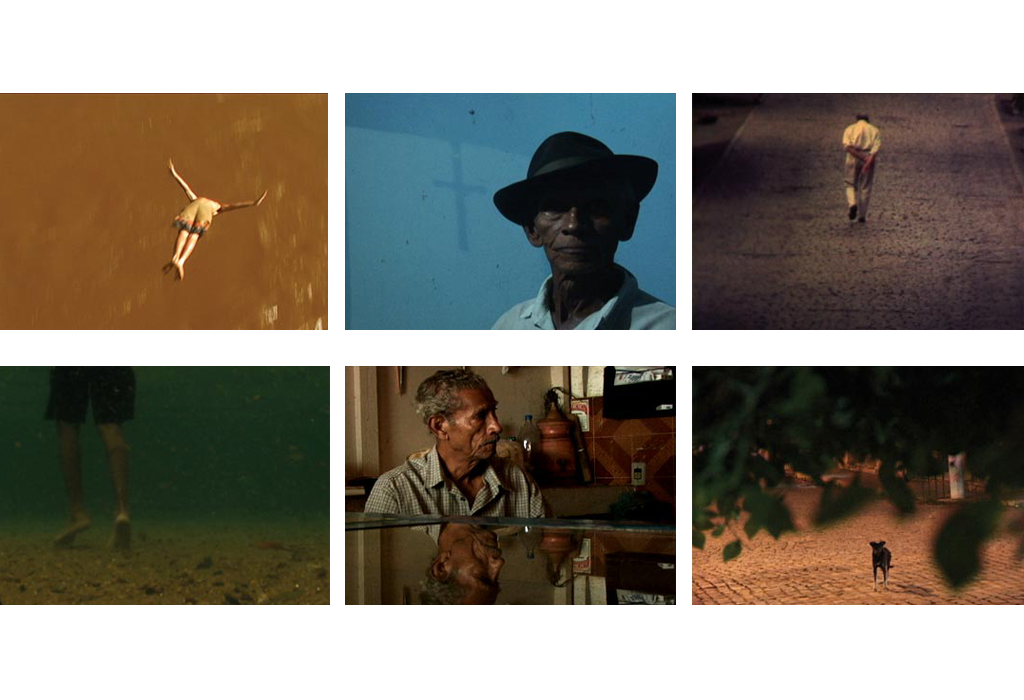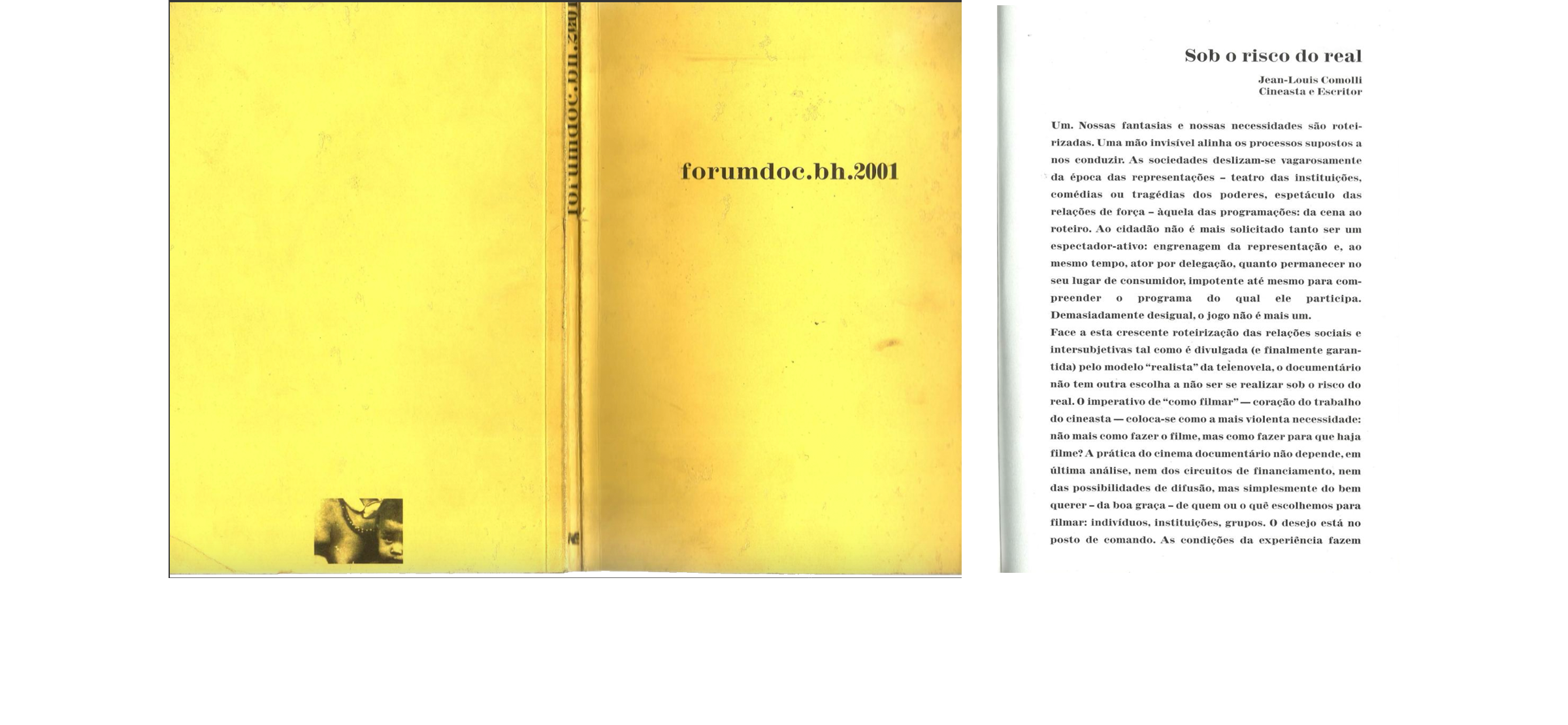At the 2013 CachoeiraDoc Festival, in Bahia, something happened that has stayed with me for nearly a decade. The festival took place in an auditorium at the Federal University of Recôncavo da Bahia (UFRB), a public university with tall roofs and a large theater where films could be screened. One evening, some students decided to project films against the white exterior wall of the auditorium. It yielded surprisingly good results. I talked with some of the artists who were present, and they agreed: there was a special shine and density to the quality of the projection. It was a small moment, this architectural deviation from exhibition standards, but it somehow seemed important. I’m still trying to figure out why.
****
I am in Brazil, where I have worked for my entire professional life in cinema. I presume that there are many similarities between the documentary festival milieu here and in other countries, particularly in the Northern Hemisphere. But there are also many differences, and I think all of them have to do with Brazil’s history of colonialism. I would start with our relation to our own archives. We have little institutional infrastructure and even less funding to preserve our history and memory. Our recent history tends toward modernization and erasing, on and on. Our relation to memory reflects the habits of a culture that has been underdeveloped.
Modernization is a term people often use to describe being influenced by the cinema of the Northern Hemisphere. In its notion of progress, the Global North imposes a standard against which everything else is measured. Progress offers an image of a future that never comes. Still, there is much to be hopeful about here in Brazil, even as the cuts and losses keep coming. Documentary festivals give us some of the best opportunities to challenge these restrictive cultural tendencies—festivals like forumdoc.bh, in Minas Gerais. And archival filmmaking offers a relatively inexpensive mode of production. In the last decade, however, efforts toward preserving and screening Brazilian archival material have diminished.{1} Even some of the larger events like Festival do Rio and It’s All True – International Documentary Film Festival used to have more slots for archival films and Brazilian cinema from the past. When the funding gets short, memory is the first thing to go. As I write this, the Cinemateca Brasileira in São Paulo burns.
****
One of our most prominent colonial legacies here in Brazil is instability. It presents itself in various ways. Regarding festivals, we could start with the instability of funding and programming. It’s common not to know if there will be a new edition of a festival in a given year, even if the previous edition was successful. This makes it hard to maintain consistency and to develop a critical mass of ideas over time. Things are constantly starting from zero. But there’s also something interesting about instability. Lack of control sometimes produces unexpected results. To be constantly beginning again is to have a chance to reimagine things.
There’s a kind of joy in the looseness produced by instability. Festivals are always social propositions, and our country has a special history of sociality. It’s not easy to explain this aspect, but I could say that, generally speaking, our colonial response to historical oppression has been an ability to invent new social practices. But this is something that happens in between the more general and visible frames—something that needs to be strategically opaque. Because, at the same time, the forces that produce these new social bonds also reinforce a fracture, a break, a division in our social tissue. This tendency toward togetherness is full of contradictions. While the goal of this tendency is to enhance collectivity, it also takes the break for granted. In some ways, this has been a functional means to resist scarcity and protect against serial violence, but it has produced an aesthetics, too. I see an abundance of Brazilian cinema that deals structurally with an idea of brokenness, of circular structures that are always starting, again and again.
I remember Carlos Adriano’s 1998 short Vassourinha: The Voice and the Void, an archival experimental film about a young Brazilian samba singer from the 1930s who suffered a premature and mysterious death. There’s an instability to Vassourinha’s samba, to his life, and to the film about him. Adriano’s film is fractured, unstable, and subtly suggestive in terms of sociality. The film is a meditation on the energy of instability, on the social and poetic habits it produces.
Excerpt from VASSOURINHA: THE VOICE AND THE VOID (Carlos Adriano, 1998).
How can a festival channel this instability into something political? How can a festival make space for what can’t be counted in advance, for the strange, for the enlargement of possibilities as a whole? What I’m searching for is a notion of how this kind of transformative social energy gets produced, and how it helps new filmmakers, new approaches, and new forms of relation to emerge. I’m looking for the qualities that allow our collectiveness and our publicness to grow; qualities that are difficult to spot through an institutional lens, because they can’t be counted. And because they require risk and patience, and a drive toward what’s unknown. A festival, I think, can only do radical political work when it relates its programming concept to its physical location, to the social practices it provides and produces, and to the territories it binds and the audiences it reaches.
****
Something unexpected happened to Brazilian film culture in the 2000s. At first there was an explosion of film festivals in general. In the early 2000s, there were less than 40 festivals in Brazil; by the end of the decade, the number grew to around 250 annual events, many of which were dedicated to documentary. Somehow, documentary broke through as a field of cinematic practice in these first years of the new millennium. The ostensible reasons for this growth in documentary film culture are various and complex: new digital technologies, the expansion of cable TV and the internet, and new public arts and cinema-funding resources. On television, programs such as DocTV—which connected new documentary productions with public TV stations—and Revelando Brazil (Revealing Brazil) embraced ambitious and radical work, and broadcast it to regions of the country that had little access to formally and politically adventurous nonfiction. (In recent years, these series have been almost wholly demolished by the Bolsonaro government.)
Each of these factors strengthened what we could call a culture of documentary in the 1990s and 2000s. There are two clear signs of this doc culture’s vitality. First, there is the It’s All True documentary festival, created in 1996, which for a long time was, among all the Brazilian festivals, the one with the biggest main prize in terms of money. Second, there is the critical prominence and influence of veteran documentarian Eduardo Coutinho, considered by many in the Brazilian film community to have built the most important body of films of the early 2000s, which provided a basis for the generations that came after. In the first decade of this century, Coutinho made a group of low-budget documentaries supported by the production company VideoFilmes (owned by João Moreira Salles and Walter Salles). Over the course of the decade, Coutinho’s films were downsized in every production aspect, yet through his conceptual intelligence and dramatic sensibility he continued to deliver maximum aesthetic results with minimal resources. By combining low-budget production with bold conceptual choices, Coutinho offered a blueprint to politically engaged nonfiction filmmakers across Brazil in the years to follow.
Two of those filmmakers are Cao Guimarães and Pablo Lobato. They produced their film Accident (2006) in the context of the DocTV production program. Their conceptual project emerges from a poem written by the directors, composed of the names of some small cities in Minas Gerais. Minas Gerais is a large state comprising almost nine hundred cities, with an immense variety of names. The filmmakers’ poem gives the names of cities that held fewer than six thousand inhabitants, and the film is filled with fragments of images and sounds from these cities, captured by small video cameras and Super 8mm footage.
The film made a strong impression on me when it was released. I watched it at Festival do Rio, and I can remember how surprised I was to see it screen there. Festival do Rio is literally a red-carpet event, dedicated to exhibiting highlights from European “A-list” festivals. The event was dedicated to neither documentary nor experimental work, and yet Accident was featured there. It even won an award. This was 2006, and I think this small situation was part of the density of documentary culture in the Brazilian environment at that moment, when unconventional films could meet conventional audiences. It was not uncommon for experimental documentary features and shorts to be included in festivals not dedicated exclusively to documentary or experimental work. At the time, these modes were part of a broader view of cinematic production here, and not relegated to the margins. Accident was even funded by the DocTV program, a television broadcaster, which is ironic since we often hear nowadays that television, public or private, exists in opposition to experimental media.
Excerpt from A FALTA QUE ME FAZ (LIKE WATER THROUGH STONE, 1998), directed by Teia collective co-founder Marilia Rocha.
It wasn’t by accident that a lot of filmmakers with visual arts backgrounds enjoyed success in Brazilian documentary festivals of the 2000s. The growth of the field of documentary practice as a whole brought with it a diversity of approaches, and opened up space for radical films in our major festivals. Never before in Brazil was documentary so consistently received and conceived as an art form, with different styles and aesthetics. Cao Guimarães, who was a product of the Belo Horizonte video art scene of the 80s and 90s, and who frequently worked with other filmmakers through the Teia collective, completed six feature documentary films from 2000 to 2010. The general project of the Teia collective and its surroundings has to do with exploring the contours—social, political, and physical—of the urban and rural landscapes of Minas Gerais. This project also has to do with rediscovering abstraction in natural patterns, and in popular culture; it’s about recognizing radical aesthetics in the chants of Aboio and in the spaces depicted in Accident. In the mid-2000s, experimental documentary enjoyed a scale of attention in Brazil that hasn’t been matched since. It wasn’t necessarily a specialized art at that time. It was just public culture. That’s no longer the case today.
****
The It’s All True festival began in 1996, and developed over the following decade into the largest documentary film festival in Brazil (and likely in Latin America). In 1996, the festival had around 40 Brazilian film submissions. In 2010, it had about 450 submissions, and today it is likely more than double that amount. Over the years, the festival has grown a reputation as the Brazilian window onto the best of international documentary festivals, particularly from Europe. Here the festival plays the role of colonial subject, taking a subaltern position of dependence on international trends and on the Northern Hemisphere, which defines Brazil’s position on many levels. It’s hard for larger events to build for themselves an identity and to have a reasonable chance at stable funding without somehow being a showcase for Northern productions coming from the A-list festivals. This likely has a lot to do with the media attention the prestige approach can garner. It’s hard to dissolve this mode of thinking—to convince people that what’s new isn’t necessarily synonymous with what’s Northern; or that what’s new doesn’t have to set the terms for what’s possible.
But maybe we are getting closer to a possible parameter that frames my interest in instability. Festivals are collective spaces, for people and films; spaces where things are made together. There’s nothing new about festivals following historical patterns of dependence upon the Global North. That form of conflating what’s new with what is Northern is an old narrative by now, one defined by repetition and redundancy.
****
Another important festival emerged in the late 90s—the forumdoc festival in the city of Belo Horizonte. Its curatorial approach is quite distinct from It’s All True. The festival operates in partnership with the Department of Anthropology at the Federal University of Minas Gerais, and in its earliest editions, it was subsidized entirely by research funds from the university. Despite a few cinematic retrospectives from the Northern Hemisphere, formudoc’s primary focus has been on local resources and experimental practices, and, more to the point, on dissolving boundaries between the two. One example is the way the festival has supported Indigenous cinema from Brazil since its very first edition. Its main venue has been what is probably the most important public theater in our country, the Sala Humberto Mauro, whose programming over the past two decades has had a deep impact on film culture at large in Brazil.{2}
Through the years, forumdoc has exerted a considerable influence on Brazilian film culture. As a person who has never lived in Minas Gerais, I have forged my bond to the region through the catalogs the festival publishes every year. These catalogs have left a visible legacy for the field of documentary studies. They remain essential reference books for Brazilian cinema, though they are not sold in bookstores. In fact, they aren’t sold at all but rather they are made available in PDF format on forumdoc’s website, following the limited number of copies printed for each festival.
To be constantly beginning again is to have a chance to reimagine things.
The forumdoc catalogs always mix original essays with translations of foreign essays in Portuguese. For instance, the catalog published essays by Pedro Costa when his cinema was far from being as influential as it became from 2005 onward. The French critic Jean-Louis Comolli’s article “Under the Risk of the Real” was translated and published in the catalog in 2001. At that time, these catalogs spread all over, especially by way of Xerox copy, which is how I first encountered them. In a certain way, they helped to provide resources for the field of documentary studies and for the humanities in general, providing access at the same time to films and texts. This is what marks forumdoc’s festival model—a grounded connection to the university and a commitment to shaping a public culture of documentary study and practice. It’s a model that takes the relation between publicness and radical aesthetics as a given.
There’s another important point to add. From its very beginning, forumdoc became the primary venue for exhibiting and producing critical conversations around Indigenous cinema from Brazil. Nũhũ Yãg Mũ Yõg Hãm: This Land Is Our Land! (Sueli Maxakali, Isael Maxakali, Carolina Canguçu, Roberto Romero, 2020) could have only received the award for Best Film in International Competition at the 2021 Sheffield DocFest, and traveled around the globe, because forumdoc has been bringing recognition and resources to Indigenous production in the region for over two decades. It’s still rare for Indigenous cinema to be featured in major cinematic events elsewhere in Brazil.
I’ve never physically been to forumdoc, but its impact on me is immeasurable. Without actually attending the festival, I have reaped the benefits of the culture it has produced. I was invited to the jury of last year’s online edition, which felt like the culmination of a relationship that began almost twenty years before. At forumdoc, I became part of a platform of ideas, texts, and programming with no clear boundaries separating them.
****
Located in Cachoeira, a historic city in Bahia with a majority Black population, CachoeiraDoc also emerged from a university humanities program. Started in 2010, the festival emphasizes experimental film programming, maintains a strong relationship with the city of Cachoeira, and, like forumdoc, is supported primarily through public funding (mainly by the Cultural Fund of the State of Bahia), making it vulnerable to political turmoil. CachoeiraDoc didn’t run in 2018 and 2019 due to lack of funding. Then it reappeared in online editions in 2020 and 2021.
I was part of the jury of the competition slate of Brazilian films in 2012, CachoeiraDoc’s third edition. The projections happened at the auditorium of the Federal University of Recôncavo da Bahia, and it was always packed with a lively audience. The students were active, and I remember the animated debates inside and outside the festival’s official events. The experience of the festival spilled into the city. The university had just been built in 2006, and it was as if the city didn’t yet know that universities are often assumed to be closed off from the life of the city’s streets. We did everything by foot around there, and as a result I was constantly talking to strangers, sometimes intensely, and only sometimes with people I knew. My attachment to misprojection underlies my general experience at CachoeiraDoc—public things, slightly out of place.
The most recent editions of the festival ran on a smaller budget than in previous years. This diminished budget has accelerated some of the festival’s commitments to the city of Cachoeira. For example, in their first edition, in 2010, the festival programmed films such as Pedro Costa’s In Vanda’s Room (2000) and Colossal Youth (2006), as well as some films by Avi Mograbi. In a later year there was a Jia Zhangke retrospective. While these films were contextualized within larger programs at CachoeiraDoc, it was clear the festival relied on such acclaimed international work for highlights that could raise public visibility. In recent years, this has changed. Budget cuts have forced CachoeiraDoc to become more local in general. The festival has decided no longer to highlight international auteurs, instead focusing exclusively on regional and national productions.
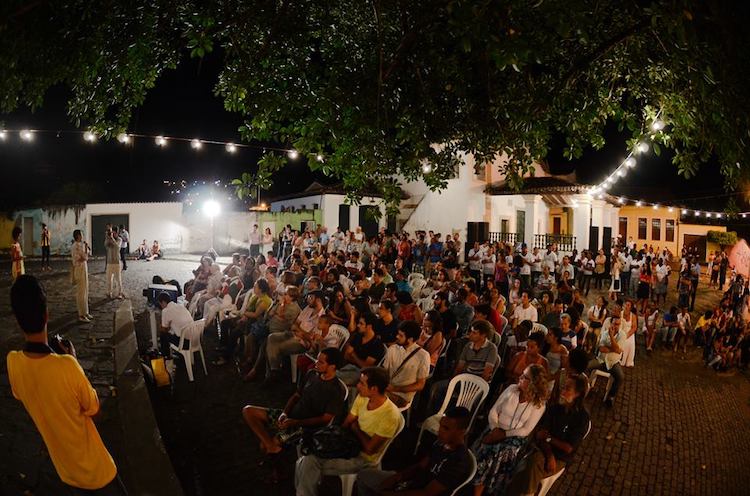 Outdoor screening at the 2013 CachoeiraDoc Festival in Cachoeira, Brazil. Image courtesy of the festival.
Outdoor screening at the 2013 CachoeiraDoc Festival in Cachoeira, Brazil. Image courtesy of the festival.
****
But let’s not romanticize funding cuts. Under Bolsonaro, our institutional infrastructures are being either rapidly destroyed or slowly asphyxiated. As we keep our cinema culture alive, the context in which we do so has changed from abundance to scarcity. The challenge now is to keep public practice alive so that we may save the institutions that are still with us. We all knew that Cinemateca Brasileira would someday burn. And then it did. It’s a difficult thing to live under the governance of the reactionary right. They announce their intention to destroy, and it’s not clear how cinema should respond. Then they do destroy, and it becomes even less clear how to react.
One response I often hear is that cinema can intervene by letting people know what’s happening. Yet the idea that cinema’s relation to change is best understood through visibility politics brings us to a dead end, I fear, because this approach offers little guidance as to how structural change can actually happen. Changing our visibilities is much easier than changing our political realities. Indeed, we import new political visibilities each festival cycle.
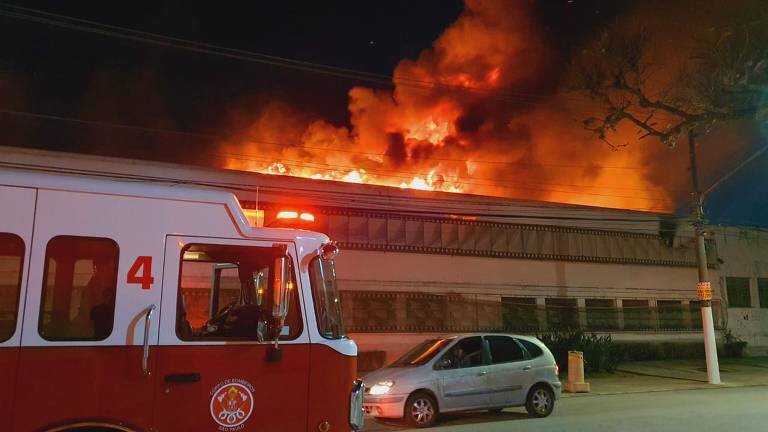 On July 29, 2021, a fire broke out at one of the storage warehouses of the Brazilian Cinematheque in São Paulo.
On July 29, 2021, a fire broke out at one of the storage warehouses of the Brazilian Cinematheque in São Paulo.
I’m more interested in how documentary festivals can bring political change through public engagement, that is, how festivals can create the conditions for cinema to be public. This has to do with forms of expression and legibility. In moments of political crisis, one camp tends to argue that the clarity of a film’s message is of utmost importance, because our fight for justice can’t afford the time and patience that experimentation sometimes demands. My feeling is that CachoeiraDoc has strengthened its reputation in our festival environment in recent years by staging this debate within cinema culture, programming urgent political cinema alongside more contemplative and patient forms.
It feels like we have no time to think about the images we see because everything we once took for granted is literally falling apart in Brazil. And this kind of rapid destruction inevitably brings back the necessity of the message-driven cinema as a mode of discourse. At the same time, when I look at the way the Brazilian radical right seems to be so attuned, not to the power of messages, but to the disruption of visuality, I believe we are in danger of letting their visual regime appear to be the only way forward. That’s metapolitics, a scrambling of the field of representation.
I think it’s clear these days that citizenship demands that we perceive between images, between films, and between daily life and historical memory. If we’re going to fight to win, we need to develop sharper sensibilities at multiple levels of public discourse. Experimental practices train our senses for that—for what is unexpected, for what’s not fully accomplished yet. This, I think, is what excited me about that moment of deviation in Cachoeira nearly a decade ago. We must welcome the opportunities afforded by misprojection.
Title Video: Accident (Cao Guimarães and Pablo Lobato, 2006).
{1} There’s been almost no new infrastructure in recent years to support the history of documentary film. Two exceptions are CineOP (Mostra de Cinema de Ouro Preto) and REcine (Archive Film Festival), both strongly dedicated to archives. But archival documentary has become more and more relegated to a ghetto. Recent restorations and digitizations of films by documentary auteurs from the 70s, such as Caravana Farkas and Aloysio Raulino, have received little attention.
{2} The Sala Humberto Mauro is the core of a very interesting cinephilic environment in the city of Belo Horizonte. There is probably no other public theater with so extensive a history of serious and creative programming. In the last twenty years it has been the main venue of local festivals such as forumdoc and FestCurtas, and of many retrospectives by foreign and Brazilian filmmakers. It was a formative place for very talented filmmakers such as André Novais Oliveira (Long Way Home, 2018) and Gabriel Martins (Mars One, 2022).


